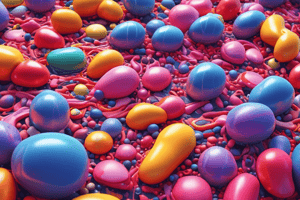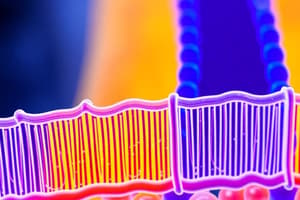Podcast
Questions and Answers
What is the main composition of all membranes, including the plasma membrane?
What is the main composition of all membranes, including the plasma membrane?
- Nucleic acids
- Carbohydrates
- Lipids and proteins (correct)
- Proteins only
How do the lipid molecules arrange themselves in the plasma membrane?
How do the lipid molecules arrange themselves in the plasma membrane?
- Hydrophilic ends facing outwards (correct)
- Random orientation
- Hydrophilic ends facing the interior of the membrane
- Hydrophobic ends facing outwards
Which type of proteins span the entire width of the membrane?
Which type of proteins span the entire width of the membrane?
- Integral membrane proteins (correct)
- Peripherally attached proteins
- Proteins that float in the lipid bilayer
- Proteins with only hydrophilic regions
What differentiates integral membrane proteins from peripheral membrane proteins?
What differentiates integral membrane proteins from peripheral membrane proteins?
In what form do carbohydrates appear in membranes?
In what form do carbohydrates appear in membranes?
What makes up a fluid mosaic in the context of membrane structure?
What makes up a fluid mosaic in the context of membrane structure?
Plasma membrane lipids form a lipid ______, a layer two molecules thick.
Plasma membrane lipids form a lipid ______, a layer two molecules thick.
The hydrophobic ends of each lipid molecule face the interior of the membrane and the hydrophilic ends face ______.
The hydrophobic ends of each lipid molecule face the interior of the membrane and the hydrophilic ends face ______.
Most proteins are embedded within, or float in, the lipid bilayer as a fluid ______.
Most proteins are embedded within, or float in, the lipid bilayer as a fluid ______.
Some proteins, because of extensive hydrophobic regions of their polypeptide chains, span the entire width of the membrane (transmembrane proteins), whereas others are only superficially attached to the bilayer by lipid ______.
Some proteins, because of extensive hydrophobic regions of their polypeptide chains, span the entire width of the membrane (transmembrane proteins), whereas others are only superficially attached to the bilayer by lipid ______.
Both are integral (intrinsic) membrane proteins, as distinct from peripheral (extrinsic) membrane proteins, which are membrane-bound only through their association with other ______.
Both are integral (intrinsic) membrane proteins, as distinct from peripheral (extrinsic) membrane proteins, which are membrane-bound only through their association with other ______.
Carbohydrates in the form of ______
Carbohydrates in the form of ______
Flashcards are hidden until you start studying



